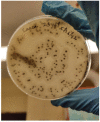Necrotic Enteritis in Broiler Chickens: A Review on the Pathogen, Pathogenesis, and Prevention
- PMID: 36296234
- PMCID: PMC9610872
- DOI: 10.3390/microorganisms10101958
Necrotic Enteritis in Broiler Chickens: A Review on the Pathogen, Pathogenesis, and Prevention
Abstract
Clostridium perfringens type A and C are the primary etiological agents associated with necrotic enteritis (NE) in poultry. The predisposing factors implicated in the incidence of NE changes the physical properties of the gut, immunological status of birds, and disrupt the gut microbial homeostasis, causing an over-proliferation of C. perfringens. The principal virulence factors contributing to the pathogenesis of NE are the α-toxin, β-toxin, and NetB toxin. The immune response to NE in poultry is mediated by the Th1 pathway or cytotoxic T-lymphocytes. C. perfringens type A and C are also pathogenic in humans, and hence are of public health significance. C. perfringens intoxications are the third most common bacterial foodborne disease after Salmonella and Campylobacter. The restrictions on the use of antibiotics led to an increased incidence of NE in poultry. Hence, it is essential to develop alternative strategies to keep the prevalence of NE under check. The control strategies rely principally on the positive modulation of host immune response, nutritional manipulation, and pathogen reduction. Current knowledge on the etiology, pathogenesis, predisposing factors, immune response, effect on the gut microbial homeostasis, and preventative strategies of NE in this post-antibiotic era is addressed in this review.
Keywords: C. perfringens; broilers; necrotic enteritis.
Conflict of interest statement
The authors declare no conflict of interest.
Figures





References
-
- Ficken M.D. Diseases of Poultry. Iowa State University Press; Uppsala, IA, USA: 1991. Necrotic enteritis; pp. 264–267.
Publication types
Grants and funding
LinkOut - more resources
Full Text Sources
Other Literature Sources

